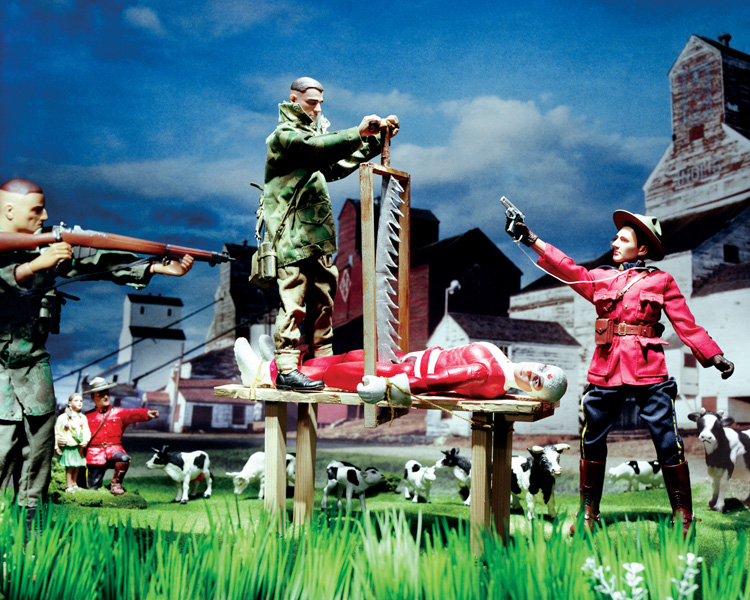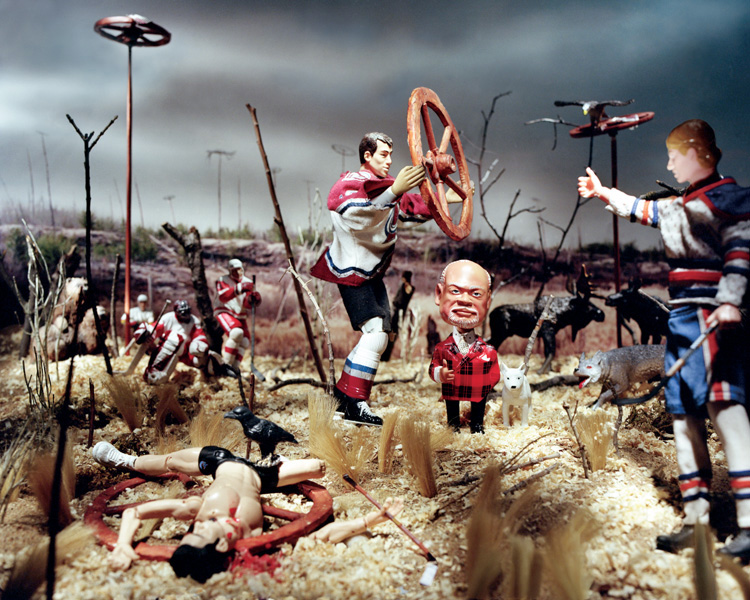[Spring 2006]
The Canadiana Martyrdom Series
Galerie Art Mûr, Montreal
November 17 – December 21, 2005
I make of Her an image of Death so as not to be shattered through the hatred I bear against myself when I identify with Her. . . . Thus the feminine as image of death is not only a screen for my fear of castration, but also an imaginary safety catch for the matricidal drive that, without such a representation, would pulverize me into melancholia if it did not drive me to crime. No, it is She who is death-bearing, therefore I do not kill myself in order to kill her but I attack her, harass her, represent her.
—Julia Kristeva, Black Sun
In her The Canadiana Martyrdom series, Diana Thorneycroft continues her courageous bid to upset all the apple-carts existing in our heads with subversive photographs that hold us uneasily suspended and drawn taut between dichotomies of laughter and tears, aesthetic delight and cringing terror, and the baroque verities of history and myth and the murderous mien of our contemporary realities.
The plastic dolls that populate these works bear, if often only barely recognizably, likenesses to figures indigenous to our popular culture. Here are the martyrs and murderers of our winter’s (Great White North) discontent. Spooky surrogates for their human counterparts, mostly kill-happy, testosterone-fuelled male lynch mobs intent on hanging ’em all high, they stalk the consciousness of the viewer like the nightmarish tropes from the Hell attributed to Hieronymus Bosch in the painting that hangs in the Doge’s Palace, Venice, wherein a multitude of piteously wailing humans are undergoing all the torments of the damned.
Within the images, adults, children, and animals look on with mirth or indifference at the slaughter of the martyrs. And the viewers of these images, poised on their thresholds? What of us? Guilty laughter? Goosebumps? Gut-sickened? Pure frisson? Vicarious thrill? Helpless witnesses, surely, to these very funky indigenous Canuck martyrdom fantasias, for it is impossible to turn away from them once they have staked their claim upon us. And they live on inside our heads like a loopy puppet theatre from Hell.
The biblical meaning of the word “martyrdom” is rooted in the Greek noun martys, meaning “witness.” Other variations of the word are the verb martyreo, which means “to bear witness,” and the noun martyria, which means the content of the testimony given. Well, the exhibited works take a cue from biblical meanings like these and their pictorial re-enactment in art history — but with a wicked and sometimes salacious and quirky contemporary twist. In palpably absurdist tableaux vivants that feature dolls, action figures, and toy animals, Thorneycroft’s unlikely medley of saints come marching in – on their way clear out of this life.
Some years ago, Thorneycroft was given a book called Torment in Art. This inspirational tome contained visual works from the rich reservoir of art history that depicted Christian martyrs being, well, martyred in all manner of consummately nasty ways. She executed her own photographic versions of these works and called the series Martyrs’ Murder. By substituting a child’s doll for the human figure, she invoked the absurd and the humorous. She has said that they had the “semblance of child’s play” – but Child’s Play the Hollywood movie more accurately, wherein the demonic doll Chucky takes on his own wholly animate, evil life dedicated to mayhem and dismemberment.
Subsequently, Thorneycroft embarked on a series called The Canadiana Martyrdom, which has been exhibited at Art Mûr. The inspiration for the series again derives from a plethora of martyrdom scenes throughout art history – one thinks of Jacques Callot’s The Martyrdom of Saint Sebastian and François Guillaume Ménageot’s The Martyrdom of Saint Sebastian very particularly. But Thorneycroft’s subjects are not Christian martyrs suffering all the torments of the damned. Here we have pop diva Céline Dion strung up, about to be unhappily released into the afterlife, in Martyrdom of St. Celine (2005), and the ubiquitous hockey commentator Don Cherry about to have his skull crushed by a humongous iron wheel in Martyrdom of St. Donald (2005). Exorcism? Catharsis? Uncensored, irreverent, night-side narrative of Eden female fantasies? The works are quite explicit and harrowing, but also tremendously funny in their way. Set in quintessentially Canadian landscapes that could have come from CBC TV footage, old CP Rail posters, or William Notman photographs, Canadian “icons” such as St. Anne of Green Gables, St. Celine Dion, and St. Don Cherry are put to the test and face the last extremity in living colour. In front of a crowd of indifferent children, their gung-ho tormentors, and a whole bestiary of polar bears, elk, moose, beavers, howling wolves, and salivating dogs, they meet their maker (and, presumably, commence their ascent heavenwards). They also, incidentally, reveal the conspicuous bravery and resonant unconscious of their maker, Diana Thorneycroft.
We want to laugh out loud at the absurdity of it all, but the darkness that moves throughout this work wells up within us, in our turn, and suddenly catches the laughter like curdled milk just before it has left our throats. Thorneycroft has a reputation as a poet of restless darkness, and this new work extends and solidifies that reputation. Yes, the martyrs seem specifically Canadian icons, but the artist alludes to the pathos of indifference, anomie, problematic Canadian cultural identity, and the national dumbed-down television crap that most of us consume like tasteless cereal at breakfast time.
From the New Testament forward, the meaning of martys as witness eventually morphed into the meaning of one who died for the witness given. Hence Thorneycroft: Canadian martyrs are arguably “believers in (or exemplars of) Canada who lose their lives prematurely, in situations of witness, as a result of human hostility.” And there is a lot of hostility in Thorneycroft’s tableaux tués. I can’t help but cite 1 Timothy 6:12 and 13, in which Paul instructed his young disciple to be a faithful witness heedless of the consequences, just as Jesus Christ had been. Timothy was martyred in 97 A.D. after he bravely condemned the orgiastic festivities of the goddess Diana in Ephesus 14.
Thorneycroft uses various martyred saints as namesakes for quintessentially Canadian “martyrs” who are being burned at the stake, castrated, drawn and quartered, immolated, hung by the neck, pierced by arrows, rendered stone-cold dead. Her palette is rich and in-your-face luscious. In Martyrdom of Capt. Canuck, the protagonist, Capt. Canuck, a Canadian costumed down-home version of Captain America caught between a rock and a sharp place, is about to lose his “wherewithal” thanks to an Edwin Holgate–like Paul the Trapper’s oversized saw. A Mountie is about to take him out with a handgun, but the outcome promises to be harrowing. The black humour induces both wanton belly laughs and a queasy sense of unease. But we never lose sight of the ferocity of Thorneycroft’s critique of male aggression and transgression, but also of the projective thrust of the male gaze itself, here drawn uncomfortably close to the edge as we witness these martyrdoms, if only though imaginative projection. If Thorneycroft invokes social madness and the delusion of crowds, she also calls into play forbidden content and the Freudian Uncanny.
Beyond black humour and the selective and seductive evisceration of Canadiana, perhaps Thorneycroft wants to unmask the real “power and destructiveness” of satanic evil synonymous with male aggression in a supposedly civilized but consummately brutal and brutalizing society. Although the idea or ideal of martyrdom seems a cruel and wholly mindless anomaly to many modern Christians, Thorneycroft has made it an aesthetic necessity. It is as though she is offering therapy for our hypocritical warped popular culture – and for herself. Guffaw or harmless placebo, there is a palpable deflation here that serves its author’s disruptive purposes right well.
Meeka Walsh, in her remarkable essay “Confusing Windows of Desire,” aligns Thorneycroft with sundry women artists whom she respects for assuming the reins of power behind the camera lens, and proffering to the public interrogatory images provocative to the male eye. Walsh says, “We read: Diana Thorneycroft’s elastic, accommodating body receives it all, is imprinted with all this specular, technical horror and we perceive an acceptance that transcends passivity. Because we do ask, on looking, where is the resistance? The body (of work) answers. In the gesture to record and to make the record artful.”1 Thorneycroft has now exteriorized all the powers of horror, but the record is no less artful. Moreover, when we move from image to image, we reflect on what an original mind is behind this work, and its artful, carnivalesque language, the courage and subversiveness and perseverance of that mind, and not lastly, her radiant heroism. There is simply no one else edgier or more original in the contemporary Canadian art pantheon.
James D. Campbell is a writer on art and an independent curator based in Montreal. He is the author of over a hundred books and catalogues on art and artists.


